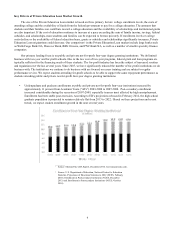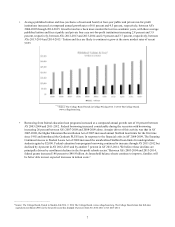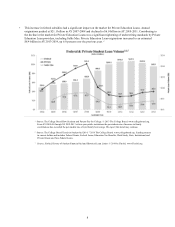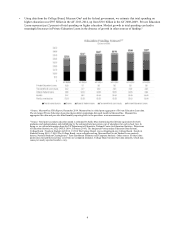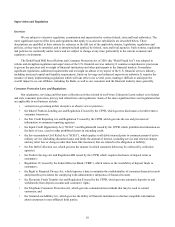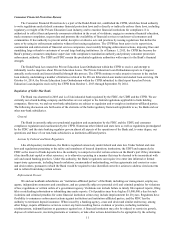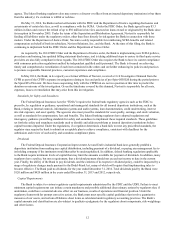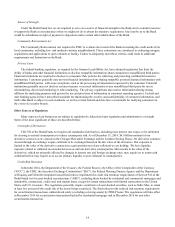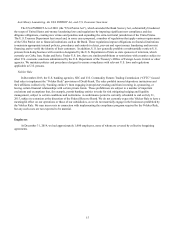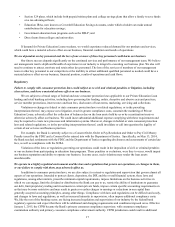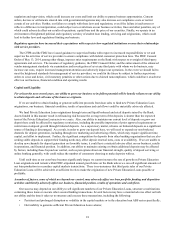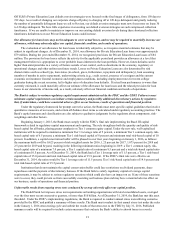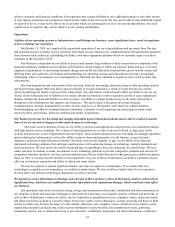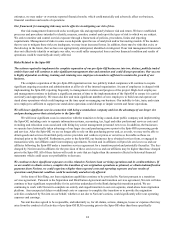Sallie Mae 2014 Annual Report Download - page 18
Download and view the complete annual report
Please find page 18 of the 2014 Sallie Mae annual report below. You can navigate through the pages in the report by either clicking on the pages listed below, or by using the keyword search tool below to find specific information within the annual report.Item 1A. Risk Factors
Economic Environment
Economic conditions could have a material adverse effect on our business, results of operations, financial condition and
liquidity.
Our business is significantly influenced by economic conditions. Economic growth in the United States remains slow and
uneven. High unemployment rates and the failure of our in-school borrowers to graduate are two of the most significant
macroeconomic factors that could increase loan delinquencies, defaults and forbearance, or otherwise negatively affect
performance of our existing education loan portfolios. Since 2009, the unemployment rate of 20-24 year old college graduates
has been higher than historical norms. It reached a high of 13.3 percent in 2011 and declined to 6.6 percent in December 2014.
Likewise, high unemployment and decreased savings rates may impede Private Education Loan originations growth as loan
applicants and their co-borrowers that experience trouble repaying credit obligations may not meet our credit standards. Current
borrowers may experience more trouble in repaying credit obligations, which could increase loan delinquencies, defaults and
forbearance. Forbearance programs may have the further effect of delaying default emergence, and alternative payment plans
may reduce the utilization of basic forbearance. In addition, some consumers may find that higher education is an unnecessary
investment during turbulent economic times and defer enrollment in educational institutions until the economy improves or turn
to less costly forms of secondary education, thus decreasing education loan application and funding volumes. Higher credit-
related losses and weaker credit quality negatively affect our business, financial condition and results of operations and limit
funding options, which could also adversely impact our liquidity position.
Competition
We operate in a competitive environment. Our product offerings are primarily concentrated in loan and savings products for
higher education.
We compete in the Private Education Loan market with banks and other consumer lending institutions, many with strong
consumer brand name recognition and greater financial resources. We compete based on our products, origination capability
and customer service. To the extent our competitors compete aggressively or more effectively, we could lose market share to
them or subject our existing loans to refinancing risk. Our product offerings may not prove to be profitable and may result in
higher than expected losses.
In addition to competition with banks and other consumer lending institutions, the federal government, through the Direct
Student Loan Program (“DSLP”), poses significant competition to our Private Education Loan products. The availability and
terms of loans the government originates or guarantees affects the demand for Private Education Loans because students and
their families often rely on Private Education Loans to bridge a gap between available funds, including family savings,
scholarships, grants and federal and state loans, and the costs of post-secondary education. The federal government currently
places both annual and aggregate limitations on the amount of federal loans any student can receive and determines the criteria
for student eligibility. These guidelines are generally adjusted in connection with funding authorizations from the U.S. Congress
for programs under the Higher Education Act of 1965. Recent federal legislation expanded federal grant and loan assistance,
which could weaken the demand for Private Education Loans. The reinstatement of FFELP, or similar federal or state programs
which make additional government loan funds available, could decrease the demand for Private Education Loans.
We are a leading provider of saving- and paying-for-college products and programs. This concentration gives us a
competitive advantage in the marketplace. This concentration also creates risks in our business, particularly in light of our
concentrations as a Private Education Loan lender. If population demographics result in a decrease in college-age individuals, if
demand for higher education decreases, if the cost of attendance of higher education decreases, if public resistance to higher
education costs increases, or if the demand for higher education loans decreases, our ability to grow Private Education Loan
originations could be negatively affected. This concentration in our business also subjects us to risks associated with changes in
repayment and prepayment rates on Private Education Loans. Most of our Smart Option Education Loan products promote
accelerated repayment. Increases in employment levels, wages, family income or alternative sources financing may also
contribute to higher prepayment rates.
Access to alternative means of financing the costs of education may reduce demand for Private Education Loans.
The demand for Private Education Loans could weaken if families and student borrowers use other vehicles to bridge the
gap between available funds and costs of post-secondary education. These vehicles include, among others:
• Home equity loans or other borrowings available to families to finance their education costs;
• Pre-paid tuition plans, which allow students to pay tuition at today’s rates to cover tuition costs in the future;
16


